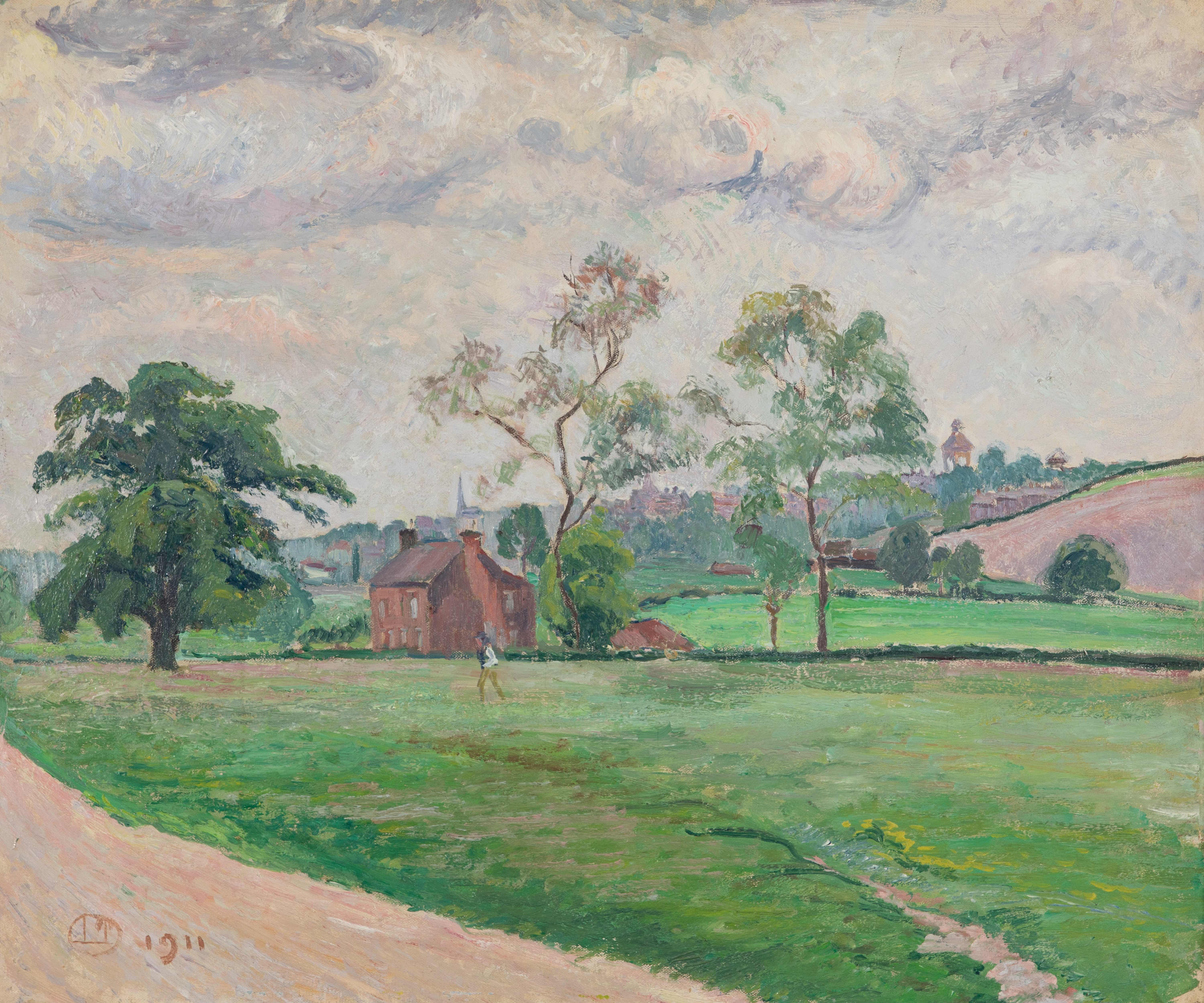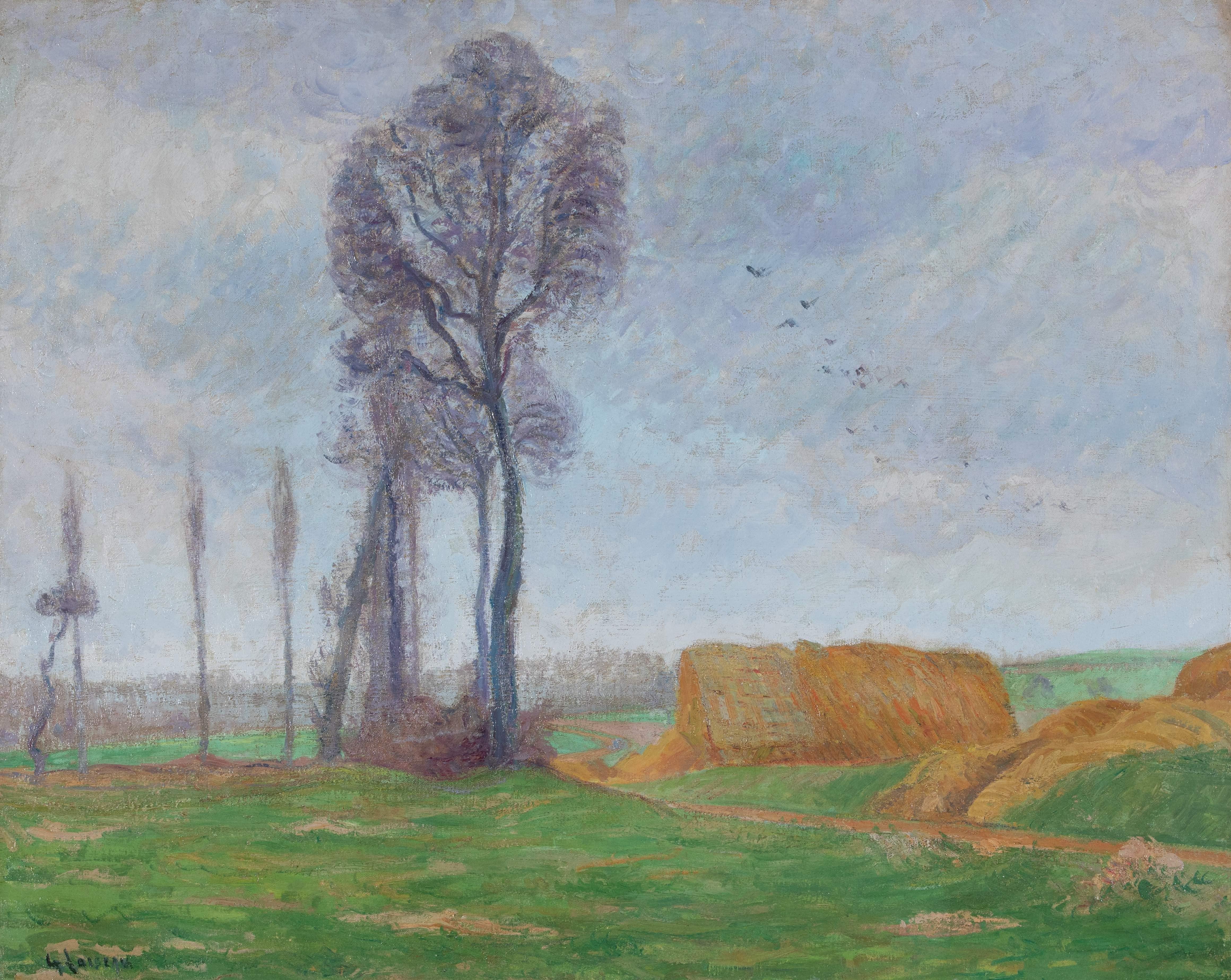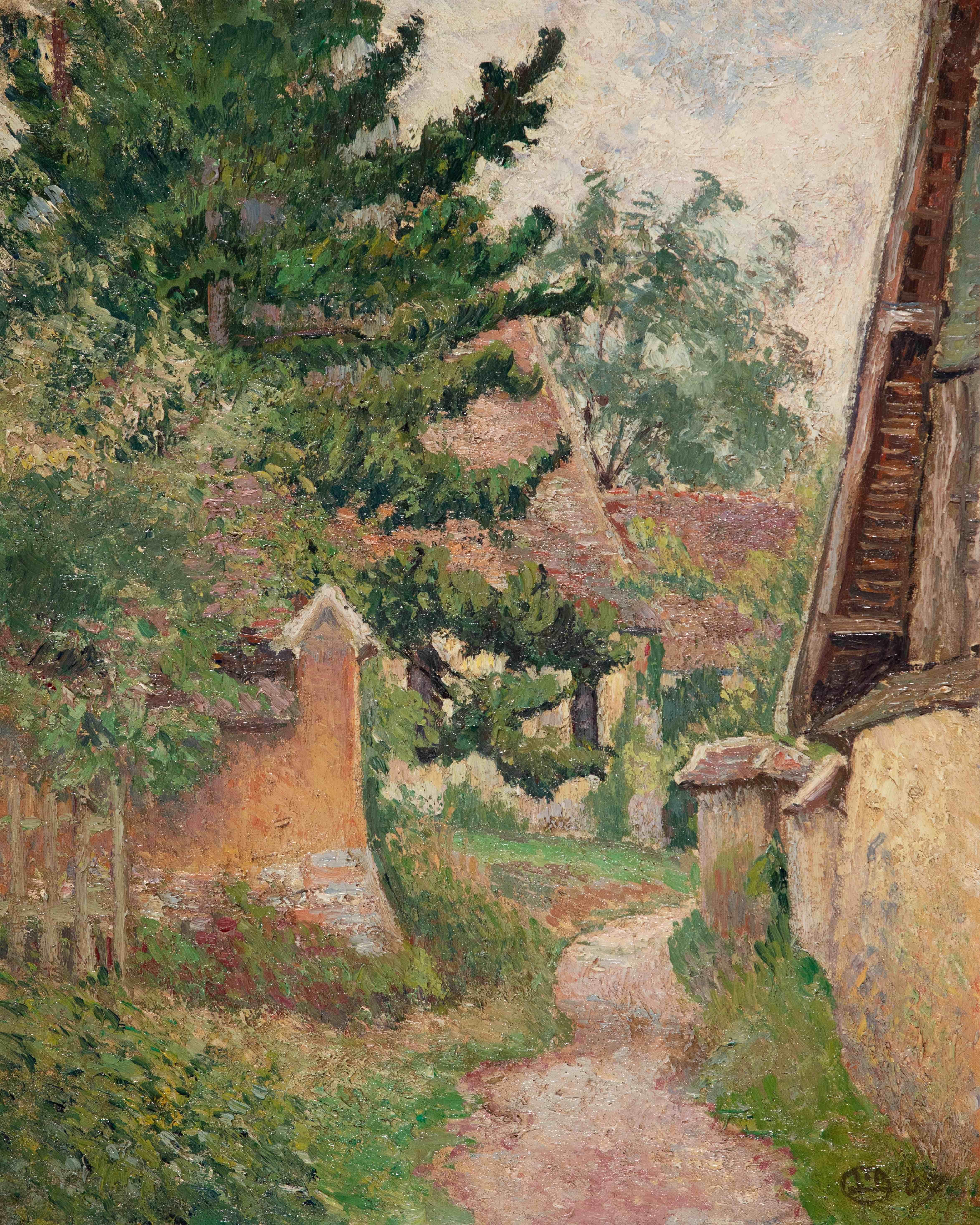Items Similar to The Garden Near Cailhau By Achille Laugé
Want more images or videos?
Request additional images or videos from the seller
1 of 10
Achille LaugéThe Garden Near Cailhau By Achille LaugéCirca 1896
Circa 1896
About the Item
Achille Laugé
1861-1944 French
The Garden Near Cailhau
Signed "A. Laugé 96" (lower left)
Oil on canvas
“Laugé’s art is one of great sensitivity and controlled reason; he is a master of light.” — Antoine Bourdelle, French Artist, Esteemed Peer, June 1927
This incredible work by Achille Laugé entitled The Garden Near Cailhau showcases the masterful artist at his very best. During his lifetime, Achille Laugé was celebrated by his peers and the public alike for producing dazzling works with subtly divided southern light, pure tones and rigorous geometry. His reputation continued to grow after his death, and today the art market recognizes him as a master of Neo-Impressionism. Though his command of the pointillist and divisionist styles often draws comparison to his Neo-Impressionist peers like Seurat and Signac, Laugé approached the style with his own unique sensibility. Laugé‘s oeuvre showcases his taste for monumental, static art emphasizing rhythm, line and purity. More personally, Laugé was deeply inspired by his hometown's natural beauty and familiarity.
The Garden Near Cailhau depicts a quintessential scene from the artist — a touching tribute to his beloved home. Featuring a road flanked by trees and bathed in sunlight, the flowering trees that line the path merge with the pointillist dots to create a stunning visual effect. The tree-lined path recedes into the distance towards the commune of Cailhau on top of a hill. The composition masterfully combines all the principles of divisionism while staying true to Laugé’s roots. Marked by a luminous color palette and a robust paint application that causes the scene to emerge in three dimensions, it is among the finest of Laugé’s output, and the canvas remains in its original unlined state in perfect condition.
The son of a farmer, Achille Laugé initially opted for a career as a pharmacist before giving up his studies to enroll at the Toulouse School of Fine Arts in 1876. During his apprenticeship, he met Antoine Bourdelle, Henri Martin and Henri Marre, who encouraged him to go to Paris in 1882 to study at the École des Beaux-Arts. It was in Paris in the early 1890s that Laugé discovered the paintings of Seurat and Signac.
He was encouraged by Bourdelle, who told him, "You bring a very personal vision, a great deal of serene logic and a beautiful gift of unity in the love of the luminous air that reigns even in your shadows" — very high praise from a peer! After his sojourn to Paris, Laugé returned to his childhood home of Cailhau near Carcassonne in the Aude, establishing himself permanently in somewhat relative isolation and only exhibiting on the rare occasion at the Salon des Indépendants in Paris. It was within this strategic isolation that the artist refined his point of view and honed his individual stylistic language.
Born in 1861 to wealthy farmers, he moved to Toulouse at the age of 17 to study pharmacy. At this time, he also enrolled part-time at the school of the Beaux-Arts, where he befriended the artist Bourdelle. Three years later, he moved to Paris, where he studied under the famous masters Alexandre Cabanel and Aristide Maillol, making his debut at the Salon in 1884. Like many other artists of his generation, Laugé eventually rejected the conservative ideals of this teacher, falling under the Post-Impressionist influence of Georges Seurat. By 1888, his landscapes became assiduous experiments in complementary colors and light on canvas. He exhibited three paintings at the Salon des Indépendants in 1894, as well as with the Nabis that same year. In addition, Laugé held several one-man shows in Paris, Toulouse and Perpignan from 1907 to 1930.
It was after his departure from Paris that Laugé developed his divisionist technique, following the lead of Seurat and the Pointillists. Although Laugé never adopted Seurat’s scientific attitude, his interest in the primacy and division of color resulted in work with a vivid, translucent palette. From 1888 until about 1896, Laugé composed his pictures with small points of color. At the end of the century, he abandoned the dots and dabs and painted his landscapes, portraits and still-lifes with thin, systematically placed strokes resembling crosshatching. After 1905, he applied his pigments more freely, with enlarged strokes and thick impasto that brought him closer to a traditional impressionist technique whilst maintaining his ability to paint the effect of southern light. Today, his exceptional works can be found at the Museum of Fine Arts, Houston and museums throughout France, including the Musée d'Orsay in Paris.
Circa 1896
Canvas: 25 1/2" high x 32" wide, 64.77 x 81.28 cm
Frame: 31 1/2" high x 37 7/8" wide, 80.01 x 96.20 cm
Provenance:
Acquired directly from the artist
Private Collection
Private Collection, Paris
M.S. Rau, New Orleans
- Creator:Achille Laugé (1861-1944, French)
- Creation Year:Circa 1896
- Dimensions:Height: 31.5 in (80.01 cm)Width: 37.88 in (96.22 cm)Depth: 1.5 in (3.81 cm)
- Medium:
- Movement & Style:
- Period:
- Condition:
- Gallery Location:New Orleans, LA
- Reference Number:
About the Seller
5.0
Vetted Seller
These experienced sellers undergo a comprehensive evaluation by our team of in-house experts.
Established in 1912
1stDibs seller since 2013
15 sales on 1stDibs
Typical response time: 5 hours
- ShippingRetrieving quote...Ships From: New Orleans, LA
- Return PolicyThis item cannot be returned.
More From This SellerView All
- Gondolas, Venetian Canal By Jane PetersonBy Jane PetersonLocated in New Orleans, LAJane Peterson 1876–1965 American Gondolas, Venetian Canal Signed “Jane Peterson” (lower right) Oil on canvas This remarkable painting, Gondolas, Venetian Canal, by the esteemed A...Category
20th Century Post-Impressionist Landscape Paintings
MaterialsCanvas, Oil
- Les Buissons Ardents By André BrasilierBy André BrasilierLocated in New Orleans, LAAndré Brasilier b. 1929 French Les buisson ardents Signed “André Brasilier” (lower right); signed, dated and inscribed "Pour Alexis. Mai 1982" (en verso) Oil on canvas Swirling w...Category
20th Century Post-Impressionist Landscape Paintings
MaterialsOil, Canvas
- Paysage Montagneux By Paul GauguinBy Paul GauguinLocated in New Orleans, LAPaul Gauguin 1848-1903 French Paysage montagneux Signed “P. Gauguin 1882” (lower right) Oil on canvas Paul Gauguin revolutionized the art world by transcending the naturalism t...Category
19th Century Post-Impressionist Landscape Paintings
MaterialsCanvas, Oil
- Almond Trees in SpringBy Achille LaugéLocated in New Orleans, LAThis Neo-Impressionist landscape by the French artist Achille Laugé captures an orchard in late spring in his celebrated, highly modern style. The work displays a thick impasto thanks to the artist's distinctive technique of applying his paint in quick dabs, a characteristic of his later works. One of the foremost painters of the Post-Impressionist period, Laugé’s works are beloved for his sensitivity to light, shade and tone, and his mastery of medium is clearly on display in Almond Trees...Category
20th Century Post-Impressionist Landscape Paintings
MaterialsOil, Canvas
- Les Falaises By Willy SchlobachBy Willy SchlobachLocated in New Orleans, LAWilly Schlobach 1864-1951 Belgian Les falaises (The Cliffs) Oil on canvas Signed with artist’s monogram “W.S.” (lower right) This coastal landscape showcases the bold palette and...Category
20th Century Post-Impressionist Landscape Paintings
MaterialsCanvas, Oil
- Notre Dame, Paris By Pierre Gaston RigaudBy Pierre Gaston RigaudLocated in New Orleans, LAPierre Gaston Rigaud 1874–1939 French Notre Dame, Paris Oil on canvas Signed "P. G. Rigaud" (lower right) This extraordinary oil on canvas titled Notre Dame, Paris is a magnifice...Category
Early 20th Century Post-Impressionist Landscape Paintings
MaterialsCanvas, Oil
You May Also Like
- Stormy Weather, Colchester by Lucien Pissarro - Landscape paintingBy Lucien PissarroLocated in London, GBStormy Weather, Colchester by Lucien Pissarro (1863-1944) Oil on canvas 54.3 x 65.3 cm (21 ³/₈ x 25 ³/₄ inches) Signed with monogram and dated lower left, 1911 Provenance: The Brook...Category
1910s Post-Impressionist Landscape Paintings
MaterialsCanvas, Oil
- Péniches sur le Loing by Georges Manzana Pissarro - Landscape paintingBy Georges Henri Manzana PissarroLocated in London, GBPéniches sur le Loing by Georges Manzana Pissarro (1871-1961) Oil on canvas 54 x 65 cm (21 ¼ x 25 ½ inches) Signed and dated lower left, G. Manzana 1902 This work is accompanied by ...Category
Early 1900s Post-Impressionist Landscape Paintings
MaterialsCanvas, Oil
- Paysage d'Automne à Nesle la Vallée by Gustave Loiseau - Landscape paintingBy Gustave LoiseauLocated in London, GB*PLEASE NOTE UK BUYERS WILL ONLY PAY 5% VAT ON THIS PURCHASE. Paysage d'Automne à Nesle la Vallée by Gustave Loiseau (1865-1935) Oil on canvas 65 X 81.2 cm (25 ⁵/₈ x 32 inches) Sign...Category
1890s Post-Impressionist Landscape Paintings
MaterialsCanvas, Oil
- Les toits de Paris, coucher de soleil by Gustave Cariot - Parisian viewsBy Gustave Camille Gaston CariotLocated in London, GB*PLEASE NOTE UK BUYERS WILL ONLY PAY 5% VAT ON THIS PURCHASE. Les toits de Paris, coucher de soleil by Gustave Cariot (1872-1950) Oil on canvas 47 ...Category
1890s Pointillist Landscape Paintings
MaterialsCanvas, Oil
- La Sente de l'Eglise, Bazincourt by Lucien Pissarro - Landscape paintingBy Lucien PissarroLocated in London, GB*PLEASE NOTE UK BUYERS WILL ONLY PAY 5% VAT ON THIS PURCHASE. La Sente de l'Eglise, Bazincourt by Lucien Pissarro (1863-1944) Oil on canvas 41.2 x 33 cm (16 ¹/₄ x 13 inches) Monogra...Category
Early 1900s Post-Impressionist Landscape Paintings
MaterialsCanvas, Oil
- Champs Elysses at Dusk, Oil Painting by Jacques GastonBy Jacques GastonLocated in Long Island City, NYArtist: Jacques Gaston, French XXth Title: Champs Elysses at Dusk Year: circa 1950 Medium: Oil on Canvas mounted to Wood, signed l.r. Image: 24 x 36 in. (60.96 x 91.44 cm) Frame: 33 ...Category
1950s Fauvist Landscape Paintings
MaterialsCanvas, Wood, Oil
Recently Viewed
View AllMore Ways To Browse
The Antique Garden
High End Antiques
End Of The Road
Ecole Home
Toulouse Antique
Monumental Painting Antique
Antique Southern Landscape
Small Garden Oil Landscape Paintings
Painting Garden Sunlight
Antique Hone
Nabi Painting
New Orleans Antique Art
The Pharmacist
Alexandre 1
Late 19th Century Post Impressionist Painting
Farmers Market
Pharmacist Art
Monumental Antique Oil Painting




